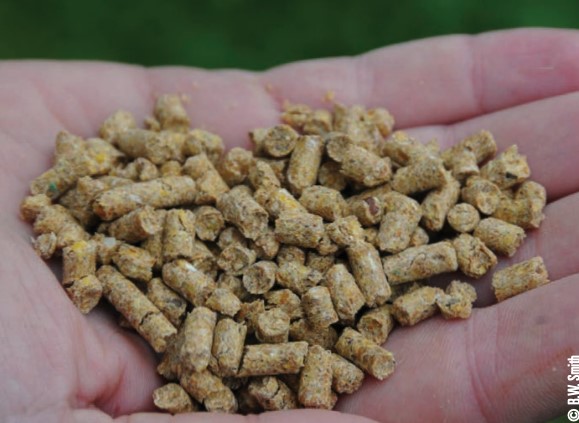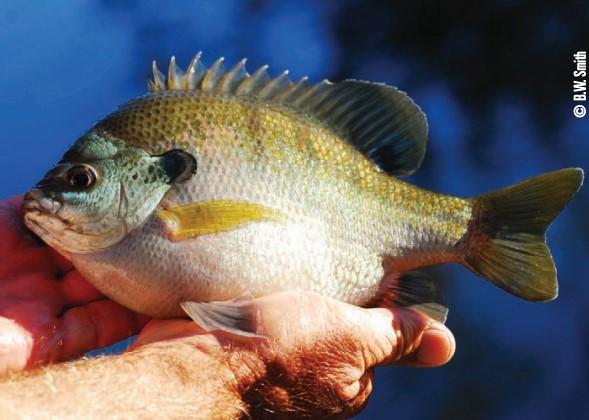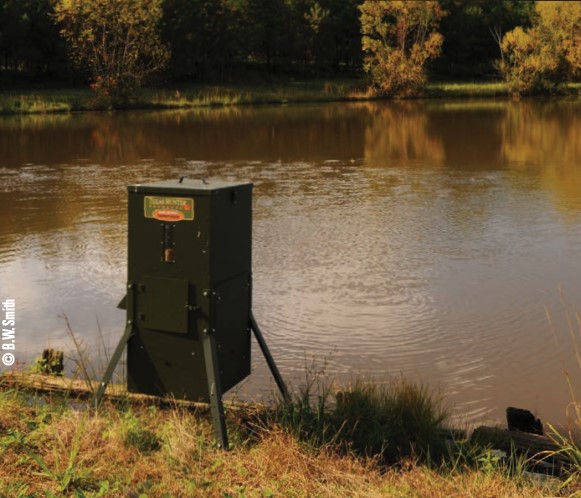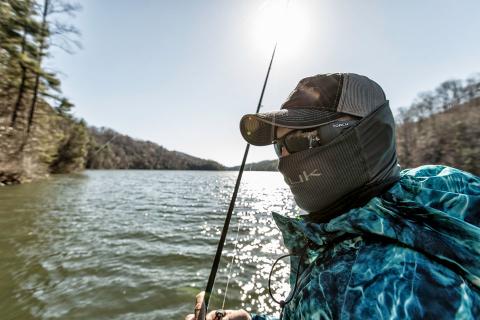Barry W. Smith | Originally published in GameKeepers: Farming for Wildlife Magazine. To subscribe, click here.
Feeding bluegill is something that most of us pond owners enjoy. We like to see our fish come to the surface and take those floating pellets. It is a way for us to observe our fish and see how much they have grown. It is also exciting to see a big bass rip through the bluegill, making them scatter like a bait pod in the Gulf of Mexico.
Adding a pelleted fish food to a recreational pond provides a food supplement for the bluegill. This adds to the existing food supply created through natural fertility or fertilization. The effect this feeding has on the bluegill population depends on the amount of food that is distributed from a specific site. If you feed multiple times a day from an automatic fish feeder and feed enough pellets that it takes the fish three to five minutes to eat it, you will fatten bluegill within the proximity of the feeder. I have seen this happen on lakes as large as 100 acres, with just a single feeder.
Feeding pond fish in the winter not only fattens them, but it can increase the total fish production in a lake. Natural productivity, or the total pounds per acre that a lake will support, is directly related to the fertility of the soil within the lake and its watershed. This is true with the production of a garden or any agricultural crop.
This productivity, however, can be dramatically increased through a proper fertilization program. Fertilizing on a regular basis with a fish pond fertilizer, such as Perfect Pond Plus, can increase your fish production as much as 300 %. Utilizing an automatic fish feeder for every five acres in a fertilized pond can push the total fish production even higher.
What Type of Feed?
Remember that feeding pond fish in the winter is just a supplement to the natural foods in your pond, and bluegill do not depend on the feed as a primary source of food. The higher the quality of fish food, the greater the growth you will see and sometimes the more fish you will see feed.
There is a tradeoff; the higher-quality feeds with more fishmeal and significantly higher protein content are very expensive. If you are on a reasonable budget, then feed a good quality catfish ration that contains 28% to 30% protein. During the spring, summer and fall, feed small floating catfish fingerling pellets.

Automatic Fish Feeders
Many pond owners like to feed their fish by hand. There is nothing wrong with this technique, but you will experience more consistent growth and feed utilization if you use an automatic fish feeder.
Bluegill have a small stomach and will respond much better to multiple feedings each day. A reliable automatic fish feeder will feed your fish when it is raining, when you have to take the kids to the doctor or soccer practice… it never forgets.
When purchasing an automatic fish feeder, don’t get the cheapest feeder at the local bargain barn. It pays to purchase a reliable directional fish feeder that can be programmed to feed multiple times a day. These quality feeders with battery and solar panel range from $500 to $800. It is one of the best long-term investments you can make for your lake.
Even if you do not want to “max out” your lake’s production, a feeder offers a number of advantages in addition to increasing the growth and size of your bluegill. It is a great place to show your friends how well your fish are growing and a place you can enjoy observing fish and their activities. Do you have kids or grandkids? It is a place where they can learn to fish, and become excited about big bluegill attacking as many crickets as you can keep on their hooks. It is a wonderful focal point for family fishing.

When Do I Quit Feeding?
Many pond owners turn off their fish feeders in the early fall when they turn on their deer feeders. The general consensus is that when the weather turns cool, the fish stop feeding.
Actually, fall and early spring are excellent growth months for bluegill. Much of the supplemental food is channeled toward growth rather than egg production, as occurs during much of the spawning season. Another little known fact is that in the southeast, growth will continue throughout the winter, although it is not as rapid as in the spring or fall.
There have been a number of interesting studies of food consumption by catfish during the winter months. Dr. Jesse Chappel, an Auburn University fisheries extension specialist, says that feeding catfish during the winter is very beneficial to commercial catfish growers.
“Commercial catfish ponds that are fed regularly from November through early March experience about a 20-percent increase in growth. Ponds that are not fed can experience a 15-percent weight loss. This can be critical in other ways, as fish that experience significant weight loss may be more susceptible to disease in the early spring,” explains Dr. Chappel.
When asked if this same principal would apply to recreational ponds with bass and bluegill, Dr. Chappel responded, “Bluegill will definitely experience a weight gain if fed during the winter months. However, since they are not totally dependent on pellets as a single food source, their weight loss may be minimal if they are not fed.”
We recommend changing to a sinking catfish pellet during the winter. Although this does not allow you to observe the fish feeding, it has several advantages. Because of the colder water temperatures, feeding response is much slower during the winter, and much of the floating food is washed upon the bank before the fish can eat it. A sinking pellet remains on the bottom for bluegill to slowly feed on over a long period of time. If conditions are too harsh for the bluegill to feed, the sinking pellet will act as organic fertilizer and increase the production of small zooplankton and insects.

Chappel says that placing structure, such as treetops or pallets, in front of the feeder will afford many of the smaller bluegill an opportunity to eat the sinking pellets while inside a refuge area.
How Often to Feed?
During the winter, we recommend feeding once daily during the middle of the afternoon. This is the time when the water is typically the warmest and will elicit the best feeding response from the bluegill. Typically, 2 p.m. to 3 p.m. is the best time to feed. Feeding duration of 6 to 10 seconds is usually adequate.
Feeding only once daily will allow you to check and fill feeders every other week. Just because hunting season is in full swing, don’t forget about your fish. Feeding pond fish in the winter does not take much effort and the reward of fat bluegill in the spring is well worth it. Keep those feeders full!
Cooking bluegill for dinner? Check out this bluegill recipe from Stacy Harris.
Barry W. Smith is a Certified Fisheries Scientist and co-owner of American Sport Fish.



























